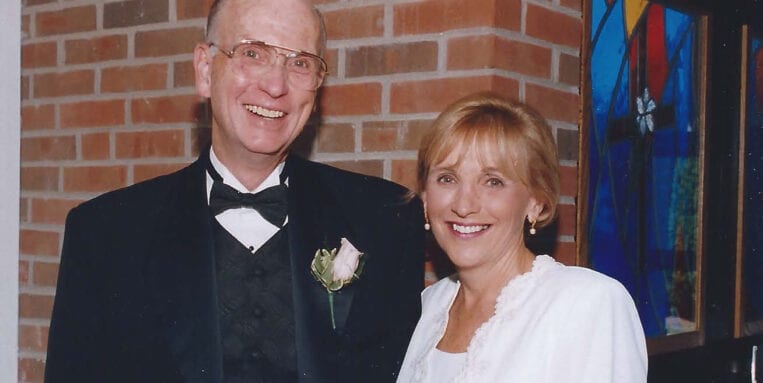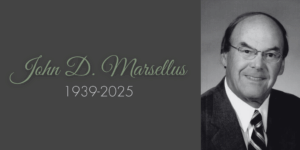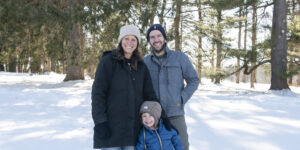William, a prominent Syracuse surgeon, was best known for founding the Clark Burn Center at University Hospital, a six-bed intensive care unit that provides state-of-the-art burn care to residents of 28 surrounding counties. He served as a Professor of Surgery in clinical practice at SUNY Upstate Medical University for 20 years and then later worked for the New York State Health Department. Dedicated to his craft, William was known for working tirelessly throughout his life to promote burn prevention in the community.
Before moving to Syracuse in 1974, William was born and raised in Michigan where he began his medical practice in impoverished rural communities. While living in the Upper Peninsula, he met a young widow named Laurie and fell in love. Together, the two moved to Syracuse where Laurie attended the Syracuse University School of Nursing. They both pursued careers in the medical field while they raised four children.
Kathryn Dearborn, a daughter of the couple, describes her parents as naturally generous, caring and compassionate. “It was part of their essence,” she said.
William started out helping others at an early age. While serving as a U.S. Army flight surgeon in Korea, he established an orphanage for area children in need. After getting married, William and Laurie continued that generosity throughout their lives, dedicating a large portion of their time to assisting local causes.
Laurie was described by her family as an extraordinary volunteer, sharing her time with the Syracuse Symphony Association, Syracuse Stage Guild and the Everson Museum Members Council. She also spent countless hours with the local garden club to beautify public spaces. William served on the board of directors of Sonnenberg Gardens and the Frederick Remington Art Museum. He also worked with Literacy Volunteers of Greater Syracuse, now known as LiteracyCNY, to teach English to Russian immigrants.
Kathryn says that this is why it is no surprise that their legacy includes a substantial contribution to ensure a vibrant community in the town that they loved.
“My father was a tough but loving man who was a true champion of the underdog and really believed everyone deserved an equal opportunity to succeed,” she said.
When William passed away in 2013 at the age of 79, his carefully crafted charitable plan was set in motion. His will called for the establishment of a marital trust to benefit Laurie for the rest of her life. When she passed away in 2016, more than $1.1 million of the trust remainder was donated to establish the Laurie J. & Dr. William Clark Jr. Community Fund.
“The choice to establish a Community Fund shows great care and concern for our community and its future needs,” said Jennifer Owens, former senior vice president and chief development officer of the Community Foundation. “Funds like these provide flexibility to our board of directors to make grants each year to nonprofit organizations that are addressing the needs in our community.”
A smaller gift that matured at the time of Dr. Clark’s death in 2013 established the Dr. William R. Clark, Jr. Fund. This designated fund perpetually supports the Frederic Remington Art Museum, Sonnenberg Gardens and the Syracuse Stage. All three organizations held special meaning to him and his family.
Endowment funds are designed to strategically benefit the community in perpetuity. We use a percentage of the fund each year to award grants to nonprofits. The remaining fund balance is invested, with the goal of growing to keep up with inflation as evidenced by an increasing annual spendable amount. Over time, the cumulative amount of grants awarded is expected to surpass the original gift used to seed the fund.
“The power of endowment takes the generosity of amazing people like William and ensures that their charitable wishes persevere through generations,” said Owens. “William had an interest in giving back to the community he loved and he put a plan in place to make it happen. We’re honored to be the stewards of his community legacy.”
Through an ongoing campaign called 5forCNY, we call on residents to consider leaving a portion of their estates to its endowment to ensure the continued support of local charities, just as Brown did. Nearly $22 billion in wealth is expected to change hands from one generation to the next in Central New York over the next few years, according to a study we commissioned. With increased mobility of heirs, this could result in fewer dollars remaining in our community – charitable or otherwise.
“People like William put their faith in our ability to honor their charitable intentions,” said Owens. “If others who also love Central New York set aside a portion of their estate for charity, we could greatly improve our region for generations.”
When not working, William was an avid canoe and cross country ski racer. His loved ones recall that while he was often up against younger, more experienced competitors, the goal was not so much about winning as about finishing, which he always did. Now, that tireless spirit is going to carry forward in his giving.









